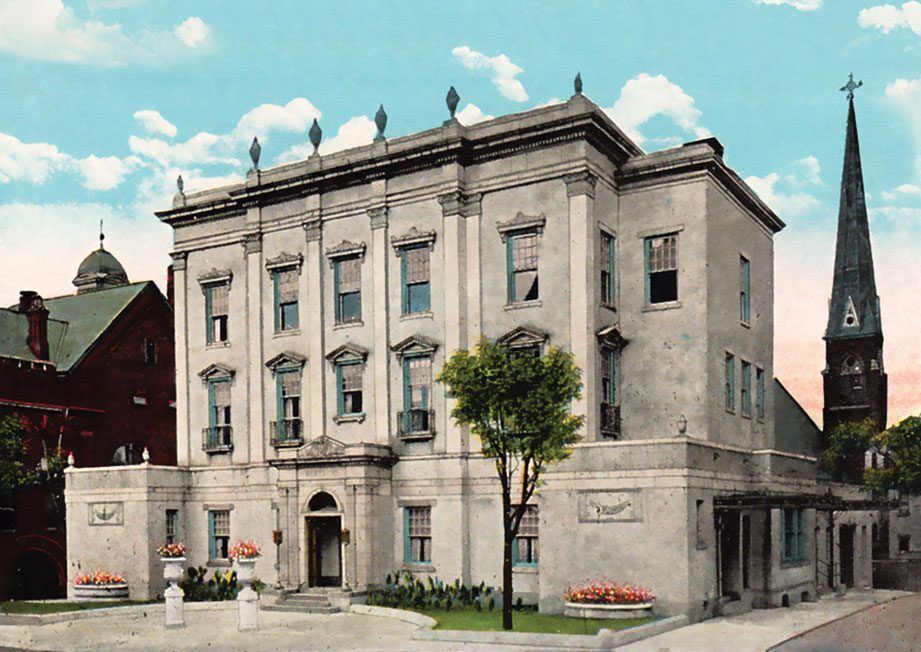The First State Capitol 1413 Eoff Street Wheeling, WV 26003-3582
Location

The First State Capitol of West Virginia
Built in 1858 as the second home of Linsly Institute, and modified to its present neo-classical look by Bertschy’s Funeral Home in the mid 1920’s, this building served as the first state capitol of West Virginia from the inception of the state on June 20, 1863 to April 1, 1870, and also from May 23, 1875 to December 4, 1876.
Arthur I. Boreman, the first governor of the new state, gave his inaugural address in front of the building on the birthday of West Virginia , June 20, 1863.
The Thirteenth Amendment to the United States Constitution, enacted in 1865 (abolishing slavery); the Fourteenth Amendment to the United States Constitution, enacted in 1868 (prohibiting States from depriving any person of life, liberty or property without due process of law); and the Fifteenth Amendment to the United State’s Constitution, enacted in 1870 (prohibiting the abridgment of the right to vote on the basis of race, color, or previous condition of servitude) were all ratified by the State of West Virginia in this building.
In addition to its service to the State of West Virginia, this building was also used by the Restored State of Virginia for two legislative sessions. During one of those sessions, in December of 1861, a grant was made by the general assembly to authorize a transfer of land in Fairfax or Alexandria Counties for use of a cemetery for the burial of persons dying in the service of the United States. Hence, the decision that culminated in the idea of the Arlington National Cemetery also originated in this building.
According to Article IV Section 3 of the United States Constitution,
New States may be admitted by the Congress into this Union, but no new State shall be formed or erected within the Jurisdiction of any other State; nor any State be formed by the Junction of two or more States, or parts of States, without the Consent of the Legislatures of the States concerned as well as of the Congress…
Prior to the Civil War, the territory which now constitutes West Virginia was part of the State of Virginia. After a convention in Richmond passed a secession ordinance on April 17th, 1861, and ordered it put to a vote of the people, the delegates and people of the western counties overwhelmingly voted against the ordinance and thereafter launched the movement to form a new state.
The leaders for the new state movement, most of them from Wheeling, knew that in order to obtain the “consent” of Virginia to form a new state within its boundaries, there needed to be created a newly constituted state of Virginia — The Restored (loyal) State of Virginia. Only Virginia, of all the Confederate States, had a “restored” state government formed during the Civil War.
The Restored State of Virginia originated at, and had its first offices at The Old Custom House, also known as Independence Hall, three blocks away at 16th and Market Street, Wheeling, West Virginia. Francis Pierpont became the first and only Governor of the Restored State of Virginia. Although the Restored State of Virginia continued its offices for the most part at the Old Custom House, it did hold two legislative sessions here at The First State Capitol, as noted above.
It was the Restored State of Virginia, that consented to the formation of the State of West Virginia within its borders. The debate over the constitutionality of the formation of the State of West Virginia continues today.
https://www.c-span.org/video/?177209-1/constitutionality-west-virginia
The building’s exterior and interior reflect the historic character (circa 1920’s) of the First State Capitol, and has been lovingly restored by its owners, Patrick and Mary Ellen Cassidy, to serve as well as a Model of Energy Efficiency. The building presently serves as the Long-time home to Mr. Cassidy’s law practice, now known as Cassidy Law, PLLC, Ohio County, WV Probation Office, The WALS Foundation, and other related or supporting businesses.
For Philosophical Consultations
Contact us today to learn more about our legal consulting and educational services.

About Us
The firm primarily represents employees, professionals, and small businesses in employment and workplace civil rights claims and other employment disputes. The firm is also engaged in a wide general practice, and emphasizes protecting the jobs and careers of its clients.
Talk To Our Attorney
Our Services
Contact Information
Main Office
The First State Capitol 1413 Eoff Street
Wheeling, WV 26003-3582
(304) 232-8200
Baltimore Office
16 South Frederick Street
Baltimore, MD 21202
(304) 232-8200
Designed By Mobilize 360

